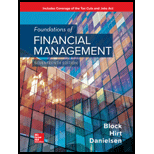
Delsing Canning Company is considering an expansion of its facilities. Its current income statement is as follows:
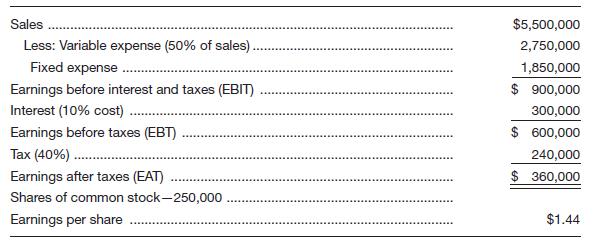
The company is currently financed with 50 percent debt and 50 percent equity (common stock, par value of $10). In order to expand the facilities, Mr. Delsing estimates a need for $2.5 million in additional financing. His investment banker has laid out three plans for him to consider:
Variable costs are expected to stay at 50 percent of sales, while fixed expenses will increase to
Delsing is interested in a thorough analysis of his expansion plans and methods of financing. He would like you to analyze the following:
a. The break-even point for operating expenses before and after expansion (in sales dollars).
b. The degree of operating leverage before and after expansion. Assume sales of
c. The degree of financial leverage before expansion and for all three methods of financing after expansion. Assume sales of
d. Compute EPS under all three methods of financing the expansion at
e. What can we learn from the answer to part d about the advisability of the three methods of financing the expansion?
a.
To calculate: The BEP (in dollars) for the operating expenses of Delsing Canning Company prior to and post expansion.
Introduction:
Break-even point (BEP):
It refers to the production level at which the revenue of the product is equal to the cost of the product. It is calculated by dividing the total fixed cost with the difference between the revenue per unit and variable cost per unit.
Answer to Problem 27P
The BEP of sales prior to the expansion of Delsing Canning Company is $3,700,000 and that post expansion is $4,700,000.
Explanation of Solution
Calculation of BEP before expansion:
Calculation of BEP after expansion:
Working Notes:
Calculation of the contribution margin ratio prior to expansion:
Calculation of the contribution margin ratio post expansion:
b.
To calculate: The DOL before and after expansion for Delsing Canning Company.
Introduction:
Degree of Operating Leverage (DOL):
It refers to the ratio that measures the change in the operating income of the company with the change in sales volume.
Answer to Problem 27P
The DOL of Delsing Canning Company before expansion is 3.06 times and that after expansion is 3.61 times.
Explanation of Solution
Calculation of DOL before expansion with sales of $5,500,000:
Calculation of DOL after expansion with sales of $6,500,000:
c.
To calculate: The DFL before and after expansion for Delsing Canning Company.
Introduction:
Degree of financial leverage (DFL):
It refers to the leverage ratio that evaluates the EPS of the company with respect to variations in its operating income. This ratio indicates that a higher DFL leads to higher earnings for the firm.
Answer to Problem 27P
The DFL before expansion for Delsing Canning Company is 1.50 times and that after expansion for plan 1 is 3.27 times, that for plan 2 is 1.50 times, and that for plan 3 is 2 times.
Explanation of Solution
Calculation of DFL before expansion:
Calculation of DFL after expansion for plan 1:
Calculation of DFL after expansion for plan 2:
Calculation of DFL after expansion for plan 3:
Working Notes:
Calculation of EBIT for plan 1 with 100% debt:
Calculation of EBIT for plan 2 with 100% equity:
Calculation of EBIT for plan 3 with 50% debt and 50% equity:
Calculation of interest for plan 1 with 100% debt:
Calculation of interest for plan 2 with 100% equity:
Calculation of interest for plan 3 with 50% debt and 50% equity:
d.
To calculate: The EPS, given that the sales in the first year were $6,500,000 and that in the last year were $10,000,000, using the three methods of financing after the expansion of Delsing Canning Company.
Introduction:
Earnings per share (EPS):
It is the profit per outstanding share of a public company. A higher EPS indicates a higher value of the company because investors are ready to pay a higher price for one share of the company.
Answer to Problem 27P
The calculation of EPS with sales of $6,500,000 for Delsing Canning Company is shown below.
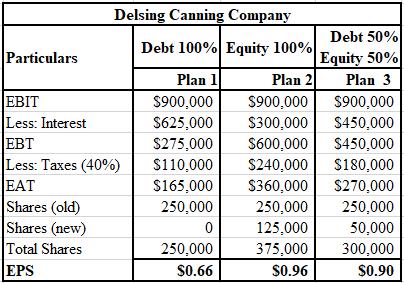
The calculation of EPS with sales of $10,500,000 for Delsing Canning Company is shown below.

Explanation of Solution
The formulae used for the calculation of EPS with sales of $6,500,000 are shown below.
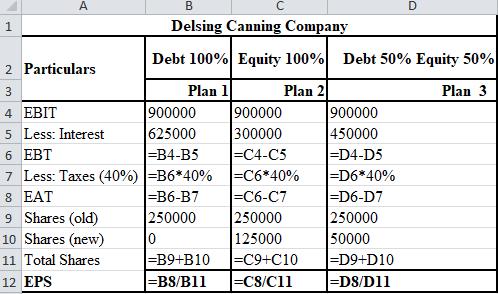
The formulae used for the calculation of EPS with sales of $10,500,000 are shown below.
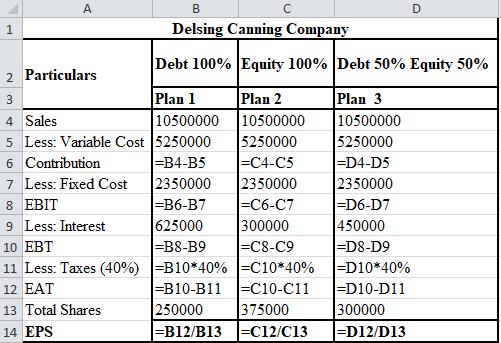
e.
To determine: The outcome of the calculation of part (d) using the three methods of financing the expansion for the Delsing Canning Company.
Introduction:
Earnings Before Interest and Tax (EBIT):
It is the profit of a firm that includes all operating and non-operating expenses. It is calculated by subtracting the cost of goods sold and operating expenses from the revenue of the corporation.
Answer to Problem 27P
When sales and profits are comparatively low, plan 2, that is, the plan with 100% equity, seems to be the best alternative in the first year. However, after expansion, when sales and profits are high, plan 1, that is, the one with 100% debt, seems to be the best one on the basis of higher yield.
Explanation of Solution
Plan 2 with 100% equity is comparatively the best alternative for the first year when there are low profits as well as sales. Moreover, with the increase in the level of sales of approximately $10.5 million, it is clear that the financial leverage has started producing results as it increased the EBIT in plan 1, which has 100% debt.
Want to see more full solutions like this?
Chapter 5 Solutions
EBK FOUNDATIONS OF FINANCIAL MANAGEMENT
- A sporting goods manufacturer has decided to expand into a related business. Management estimates that to build and staff a facility of the desired size and to attain capacity operations would cost $450 million in present value terms. Alternatively, the company could acquire an existing firm or division with the desired capacity. One such opportunity is a division of another company. The book value of the division’s assets is $250 million and its earnings before interest and tax are presently $50 million. Publicly traded comparable companies are selling in a narrow range around 12 times current earnings. These companies have book value debt-to-asset ratios averaging 40 percent with an average interest rate of 10 percent. a. Using a tax rate of 34 percent, estimate the minimum price the owner of the division should consider for its sale. b. What is the maximum price the acquirer should be willing to pay? c. Does it appear that an acquisition is feasible? Why or why not? d. Would a 25…arrow_forwardLarry Davis borrows $80,000 at 14 percent interest toward the purchase of a home. His mortgage is for 25 years. a. How much will his annual payments be? (Although home payments are usually on a monthly basis, we shall do our analysis on an annual basis for ease of computation. We will get a reasonably accurate answer.) b. How much interest will he pay over the life of the loan? c. How much should be willing to pay to get out of a 14 percent mortgage and into a 10 percent mortgage with 25 years remaining on the mortgage? Assume current interest rates are 10 percent. Carefully consider the time value of money. Disregard taxes.arrow_forwardYou are chairperson of the investment fund for the local closet. You are asked to set up a fund of semiannual payments to be compounded semiannually to accumulate a sum of $250,000 after nine years at a 10 percent annual rate (18 payments). The first payment into the fund is to take place six months from today, and the last payment is to take place at the end of the ninth year. Determine how much the semiannual payment should be. (a) On the day, after the sixth payment is made (the beginning of the fourth year), the interest rate goes up to a 12 percent annual rate, and you can earn a 12 percent annual rate on funds that have been accumulated as well as all future payments into the funds. Interest is to be compounded semiannually on all funds. Determine how much the revised semiannual payments should be after this rate change (there are 12 payments and compounding dates). The next payment will be in the middle of the fourth year.arrow_forward
- If your Uncle borrows $60,000 from the bank at 10 percent interest over the seven-year life of the loan, what equal annual payments must be made to discharge the loan, plus pay the bank its required rate of interest? How much of his first payment will be applied to interest? To principal? How much of his second payment will be applied to each?arrow_forwardQ1: You are an analyst in charge of valuing common stocks. You have been asked to value two stocks. The first stock NEWER Inc. just paid a dividend of $6.00. The dividend is expected to increase by 60%, 45%, 30% and 15% per year, respectively, in the next four years. Thereafter, the dividend will increase by 4% per year in perpetuity. Calculate NEWER’s expected dividend for t = 1, 2, 3, 4 and 5.The required rate of return for NEWER stock is 14% compounded annually.What is NEWER’s stock price?The second stock is OLDER Inc. OLDER Inc. will pay its first dividend of $10.00 three (3) years from today. The dividend will increase by 30% per year for the following four (4) years after its first dividend payment. Thereafter, the dividend will increase by 3% per year in perpetuity. Calculate OLDER’s expected dividend for t = 1, 2, 3, 4, 5, 6, 7 and 8.The required rate of return for OLDER stock is 16% compounded annually.What is OLDER’s stock price?Now assume that both stocks have a required…arrow_forwardQ1: Blossom is 30 years old. She plans on retiring in 25 years, at the age of 55. She believes she will live until she is 105. In order to live comfortably, she needs a substantial retirement income. She wants to receive a weekly income of $5,000 during retirement. The payments will be made at the beginning of each week during her retirement. Also, Blossom has pledged to make an annual donation to her favorite charity during her retirement. The payments will be made at the end of each year. There will be a total of 50 annual payments to the charity. The first annual payment will be for $20,000. Blossom wants the annual payments to increase by 3% per year. The payments will end when she dies. In addition, she would like to establish a scholarship at Toronto Metropolitan University. The first payment would be $80,000 and would be made 3 years after she retires. Thereafter, the scholarship payments will be made every year. She wants the payments to continue after her death, therefore…arrow_forward
- Q1: Blossom is 30 years old. She plans on retiring in 25 years, at the age of 55. She believes she will live until she is 105. In order to live comfortably, she needs a substantial retirement income. She wants to receive a weekly income of $5,000 during retirement. The payments will be made at the beginning of each week during her retirement. Also, Blossom has pledged to make an annual donation to her favorite charity during her retirement. The payments will be made at the end of each year. There will be a total of 50 annual payments to the charity. The first annual payment will be for $20,000. Blossom wants the annual payments to increase by 3% per year. The payments will end when she dies. In addition, she would like to establish a scholarship at Toronto Metropolitan University. The first payment would be $80,000 and would be made 3 years after she retires. Thereafter, the scholarship payments will be made every year. She wants the payments to continue after her death, therefore…arrow_forwardJerome Moore invests in a stock that will pay dividends of $2.00 at the end of the first year; $2.20 at the end of the second year; and $2.40 at the end of the third year. also, he believes that at the end of the third year he will be able to sell the stock for $33. what is the present value of all future benefits if a discount rate of 11 percent is applied?arrow_forwardQ1: You are an analyst in charge of valuing common stocks. You have been asked to value two stocks. The first stock NEWER Inc. just paid a dividend of $6.00. The dividend is expected to increase by 60%, 45%, 30% and 15% per year, respectively, in the next four years. Thereafter, the dividend will increase by 4% per year in perpetuity. Calculate NEWER’s expected dividend for t = 1, 2, 3, 4 and 5.The required rate of return for NEWER stock is 14% compounded annually.What is NEWER’s stock price?The second stock is OLDER Inc. OLDER Inc. will pay its first dividend of $10.00 three (3) years from today. The dividend will increase by 30% per year for the following four (4) years after its first dividend payment. Thereafter, the dividend will increase by 3% per year in perpetuity. Calculate OLDER’s expected dividend for t = 1, 2, 3, 4, 5, 6, 7 and 8.The required rate of return for OLDER stock is 16% compounded annually.What is OLDER’s stock price?Now assume that both stocks have a required…arrow_forward
- Q1: You are an analyst in charge of valuing common stocks. You have been asked to value two stocks. The first stock NEWER Inc. just paid a dividend of $6.00. The dividend is expected to increase by 60%, 45%, 30% and 15% per year, respectively, in the next four years. Thereafter, the dividend will increase by 4% per year in perpetuity. Calculate NEWER’s expected dividend for t = 1, 2, 3, 4 and 5.The required rate of return for NEWER stock is 14% compounded annually.What is NEWER’s stock price?The second stock is OLDER Inc. OLDER Inc. will pay its first dividend of $10.00 three (3) years from today. The dividend will increase by 30% per year for the following four (4) years after its first dividend payment. Thereafter, the dividend will increase by 3% per year in perpetuity. Calculate OLDER’s expected dividend for t = 1, 2, 3, 4, 5, 6, 7 and 8.The required rate of return for OLDER stock is 16% compounded annually.What is OLDER’s stock price?Now assume that both stocks have a required…arrow_forwardQ1: Blossom is 30 years old. She plans on retiring in 25 years, at the age of 55. She believes she will live until she is 105. In order to live comfortably, she needs a substantial retirement income. She wants to receive a weekly income of $5,000 during retirement. The payments will be made at the beginning of each week during her retirement. Also, Blossom has pledged to make an annual donation to her favorite charity during her retirement. The payments will be made at the end of each year. There will be a total of 50 annual payments to the charity. The first annual payment will be for $20,000. Blossom wants the annual payments to increase by 3% per year. The payments will end when she dies. In addition, she would like to establish a scholarship at Toronto Metropolitan University. The first payment would be $80,000 and would be made 3 years after she retires. Thereafter, the scholarship payments will be made every year. She wants the payments to continue after her death, therefore…arrow_forwardTrue and False 1. There are no more than two separate phases to decision making and problem solving. 2. Every manager always has complete control over all inputs and factors. 3. Opportunity cost is only considered by accountants as a way to calculate profits 4. Standard error is always used to evaluate the overall strength of the regression model 5. The t-Stat is used in a similar way as the P-valued is used 6. The P-value is used as R-square is used. 7. R-square is used to evaluate the overall strength of the model. 8. Defining the problem is one of the last things that a manager considers Interpreting Regression Printouts (very brief answers) R² = .859 Intercept T N = 51 Coefficients 13.9 F= 306.5 Standard Error .139 SER=.1036 t Stat P value 99.8 0 .275 .0157 17.5 0 The above table examines the relationship between the nunber, of poor central city households in the U.S. and changes in the costs of college tuition from 1967 to 2019. 9. What is the direction of this relationship? 10.…arrow_forward
 EBK CONTEMPORARY FINANCIAL MANAGEMENTFinanceISBN:9781337514835Author:MOYERPublisher:CENGAGE LEARNING - CONSIGNMENT
EBK CONTEMPORARY FINANCIAL MANAGEMENTFinanceISBN:9781337514835Author:MOYERPublisher:CENGAGE LEARNING - CONSIGNMENT


